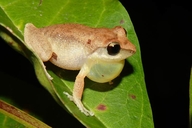|
Description
Eleutherodactylus ronaldi is a member of the Eleutherodactylus auriculatus group (subgenus Eleutherodactylus). The digital discs are large. There is no webbing between the toes. The vomerine teeth, behind the choanae, are in a short and straight series (Schwartz 1960; Schwartz and Henderson 1985; Schwartz and Henderson 1991). It is tan with a pale mid-dorsal hairline or a series of seven transverse bars. There is a faint interocular bar or triangle, and a dark brown face mask. The concealed surfaces of the hind limbs are dark brown. The venter is heavily stippled with brown, profusely spotted with white dots. The vocal sac and throat are pale yellow, stippled with brown. (Schwartz 1960; Schwartz and Henderson 1985; Schwartz and Henderson 1991). Distribution and Habitat
Country distribution from AmphibiaWeb's database: Cuba
This species is endemic to Cuba and it is found only in the Sierra Maestra and Sagua-Baracoa mountains, in eastern Cuba. It occurs in lowland and upland mesic broadleaf forests, and occasionally in pinewoods (Schwartz and Henderson 1991).Life History, Abundance, Activity, and Special Behaviors
This frog is active at night. Males vocalize from shrubs and trees with dense foliage, up to 3 meters above the ground. Vocalization is a slow nonmetallic rapping composed of short “ticks” repeated many times in close, regular intervals (343-405 calls/minute). The dominant frequency is about 3.7-3.8 kHz (Schwartz 1960; Schwartz and Henderson 1991; Hedges et al. 1992). Trends and Threats
This species is threatened by habitat destruction as a result of deforestation due to agriculture, woodcutting, disturbance from tourists, and infrastructure development for human settlement (Hedges and Diaz 2004). Possible reasons for amphibian decline General habitat alteration and loss
Habitat modification from deforestation, or logging related activities
Intensified agriculture or grazing
Urbanization
Comments
Eleutherodactylus ronaldi is a member of the Eleutherodactylus auriculatus group (subgenus Eleutherodactylus). Related species include Eleutherodactylus mariposa, E. auriculatus, E. glamyrus, E. bartonsmithi and E. auriculatus (Heinicke et al. 2007). Etymology- Named for Ronald F. Klinikowski, who accompanied the author in collecting the type-series (Schwartz 1960).
References
Cope, E. D. (1862). ''On some new and little known American anura.'' Proceedings of the Academy of Natural Sciences of Philadelphia, 14, 151-159.
Hedges, S. B. and Díaz, L. M. (2004). Eleutherodactylus ronaldi. In: IUCN 2007. 2007 IUCN Red List of Threatened Species. http://www.iucnredlist.org/. Downloaded on 11 November 2007.
Hedges, S.B., Estrada, A.R., and Thomas, R. (1992). ''Three new species of Eleutherodactylus from eastern Cuba, with notes on vocalizations of other species (Anura: Leptodactylidae).'' Herpetological Monographs, 6, 68-83.
Heinicke, M. P., Duellman, W. E., Hedges, S. B. (2007). ''Major Caribbean and Central American frog faunas originated by ancient oceanic dispersal.'' Proceedings of the National Academy of Sciences of the United States of America, 104(24), 10092-10097.
Schwartz, A. (1960). ''Nine new Cuban frogs of the genus Eleutherodactylus.'' Science Publishers Reading Public Museum Art Gallery, 11, 1-50.
Schwartz, A., and Henderson, R. W. (1985). A Guide to the Identification of the Amphibians and Reptiles of the West Indies Exclusive of Hispaniola. Milwaukee Public Museum, Inland Press, Milwaukee.
Originally submitted by: Ansel Fong G. (first posted 2007-11-07)
Edited by: Kellie Whittaker (2007-11-12)Species Account Citation: AmphibiaWeb 2007 Eleutherodactylus ronaldi: Cuban Khaki Frog <https://amphibiaweb.org/species/3179> University of California, Berkeley, CA, USA. Accessed Nov 26, 2024.
Feedback or comments about this page.
Citation: AmphibiaWeb. 2024. <https://amphibiaweb.org> University of California, Berkeley, CA, USA. Accessed 26 Nov 2024.
AmphibiaWeb's policy on data use.
| 